When Stephan Schaller, President of BMW Motorrad, took the stage at the 2013 EICMA motorcycle show in Milan, Italy, he described the new 2014 R1200RT as a vehicle for "relaxed but dynamic riding on long-distance holidays." With all due respect to Herr Schaller, he just as easily could have been talking about the previous R1200RT, the boxer-engine sport-tourer that has developed a loyal following in the U.S. and abroad. So what is it that really makes the 2014 R1200RT different?
Well, just about everything. The main frame is stronger, for greater directional stability, and the rider triangle formed by the handlebars, seat and footpegs has been lowered nearly an inch (20mm) to make it much easier for a short rider’s boots to reach the ground. Moreover, new bodywork with the power-adjustable windscreen is said to offer much better weather protection, Schaller even going so far as to say that the rider stays “nearly dry” in the rain.
While all this is important, the new boxer engine is the most significant change. It's the same air- and liquid-cooled 1170cc unit found in the R1200GS, but now fitted with a heavier crankshaft and alternator to add powertrain smoothness while also making the bike harder to stall. Peak power is listed as 125 hp at 7,750 rpm, complemented by 92 pound-feet of torque at 6,500 rpm. This compares favorably to the air- and oil-cooled boxer in the 2013 BMW R1200RT, which produced a claimed 110 hp at 7,750 rpm and 89 pound-feet of torque at 6,000.
2014 BMW R1200RT at EICMA 2013
As you’d expect, technology abounds in BMW’s newest classic tourer, largely to improve rider safety. Automatic Stability Control and ABS are standard, as are two riding modes: Road and Rain. When the latter is selected, throttle response is gentle, traction control intervenes readily, and the suspension switches to soft damping. In Road, the new R1200RT boasts what BMW calls an “optimum balance” of performance and comfort, but let it be known that there’s an even sportier setting available when the Pro riding mode is ordered. It’s called Dynamic, and it provides “instant” throttle response, even less ABS and TC intervention, plus firm damping. Hill Start Control is a part of Pro mode; this new system won’t allow your R1200RT to roll back while you’re starting on an uphill slope. What a boon this will be for riders in San Francisco, especially when considering that the new R1200RT tips the scales at a claimed 604 lb. in wet, ready-to-ride form.
On top of all that, the new RT has two other significant performance-related options. The first, Dynamic ESA, offers the same basic damping and load settings as the ESA available in the previous R1200RT, but preload and spring rates are now adjustable. Of note, BMW says the attitude of an R1200RT with Dynamic ESA barely changes when it’s accelerating or braking, and the bike’s directional stability is greatly enhanced.
The second option is a quick-shifter. Called BMW Gearshift Assistant Pro, it’s a dealer-installed option that allows clutchless upshifting and downshifting without adjusting the ride-by-wire throttle, as long as the bike is in proper load and rev ranges. While the quick-shifter may seem a bit out of place on a luggage-hauling bike, BMW says it’s a way to help the R1200RT fuse travel with sporty performance. We laud the effort, especially if the quick-shifter works as described.
In other significant news, the R1200RT’s multifunctional instrument cluster has had a complete redesign. There’s now a high-definition 5.7-inch TFT (thin film transistor) color display, replete with BMW Motorrad’s onboard computer and audio controls, all supplemented by an analog tachometer and speedometer. The audio system, like that of the K1600 models, allows for iPods, MP3s, Bluetooth and for the reception of Sirius XM.
While at times it seems that all these creature comforts can get in the way of what's important to a motorcycle, the role of sport-tourer is a tough one. On one hand, we want the new R1200RT to be as plush and feature-filled as a K1600. On the other, it must be reasonably quick, able to avoid being totally embarrassed by sportbikes in the twisties. And while it certainly looks like the 2014 BMW R1200RT—with its strong chassis, better engine and optional Dynamic ESA working its suspension magic—has made a step in the right direction, only a Cycle World test will tell for sure.










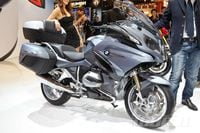
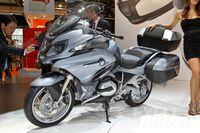
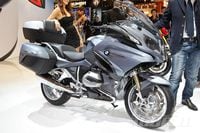
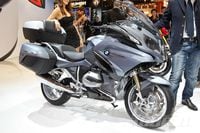
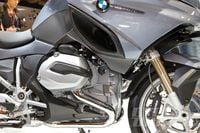
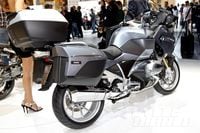
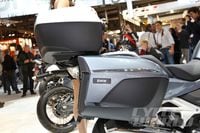
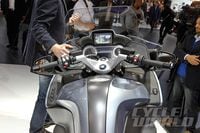
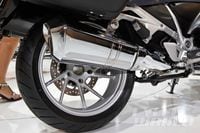
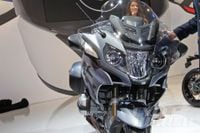
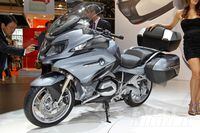
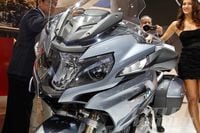

/cloudfront-us-east-1.images.arcpublishing.com/octane/LYR62CH2WNBMHJJVXVATZHOUE4.jpg)
/cloudfront-us-east-1.images.arcpublishing.com/octane/RBCTRGBQYBDK7A6XPG3HKPS7ZQ.jpg)
/cloudfront-us-east-1.images.arcpublishing.com/octane/MQXQRYMZVBCWJIRYP3HEN3SHVE.jpg)
/cloudfront-us-east-1.images.arcpublishing.com/octane/TSPODNNEWRDSVJGUCNQTDG4ADI.jpg)
/cloudfront-us-east-1.images.arcpublishing.com/octane/X5TB7BDV4BA2RPSY54ZGK27RP4.jpg)
/cloudfront-us-east-1.images.arcpublishing.com/octane/REUHOJXRDBGZ5IHBYZCCBCISPA.jpg)
/cloudfront-us-east-1.images.arcpublishing.com/octane/52LGJTCKBFEHDF7S7H4CVUIMGM.jpg)
/cloudfront-us-east-1.images.arcpublishing.com/octane/YMWAIPIPSJAOXOU3QMJMGH37OM.jpg)


/cloudfront-us-east-1.images.arcpublishing.com/octane/EJ6KZRGAYBCVXNL2PJXL37UVWQ.jpg)
/cloudfront-us-east-1.images.arcpublishing.com/octane/AAN4TI76M5H5JMUVEIGASWXBDU.jpg)
/cloudfront-us-east-1.images.arcpublishing.com/octane/P3RXD2UCPFF37CMB7CHPVKXORY.jpg)
/cloudfront-us-east-1.images.arcpublishing.com/octane/VZEG2EJI2RDFZNHLRZMU56MD3Q.jpg)
/cloudfront-us-east-1.images.arcpublishing.com/octane/GVJQO5FFOFBWNGODOBRB4FBAW4.jpg)
/cloudfront-us-east-1.images.arcpublishing.com/octane/BIVAK2SFIBDJJM25E7I5VU2FJE.jpg)
/cloudfront-us-east-1.images.arcpublishing.com/octane/CH5VX52UG5CFHOVH5A6UYEFWWA.jpg)
/cloudfront-us-east-1.images.arcpublishing.com/octane/ZVGJNGZRU5C33N7KN23BBFKSC4.jpg)

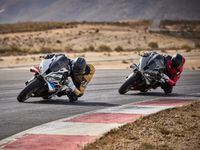
/cloudfront-us-east-1.images.arcpublishing.com/octane/CZ5OM3E43ZEXJHY7LCYXCHLIKI.jpg)
/cloudfront-us-east-1.images.arcpublishing.com/octane/DF5T4K5KPZFJXFCTGPYR77PKJM.jpg)
/cloudfront-us-east-1.images.arcpublishing.com/octane/RMCT2KVQBJHBZMRTSLOVPMOILU.jpg)
